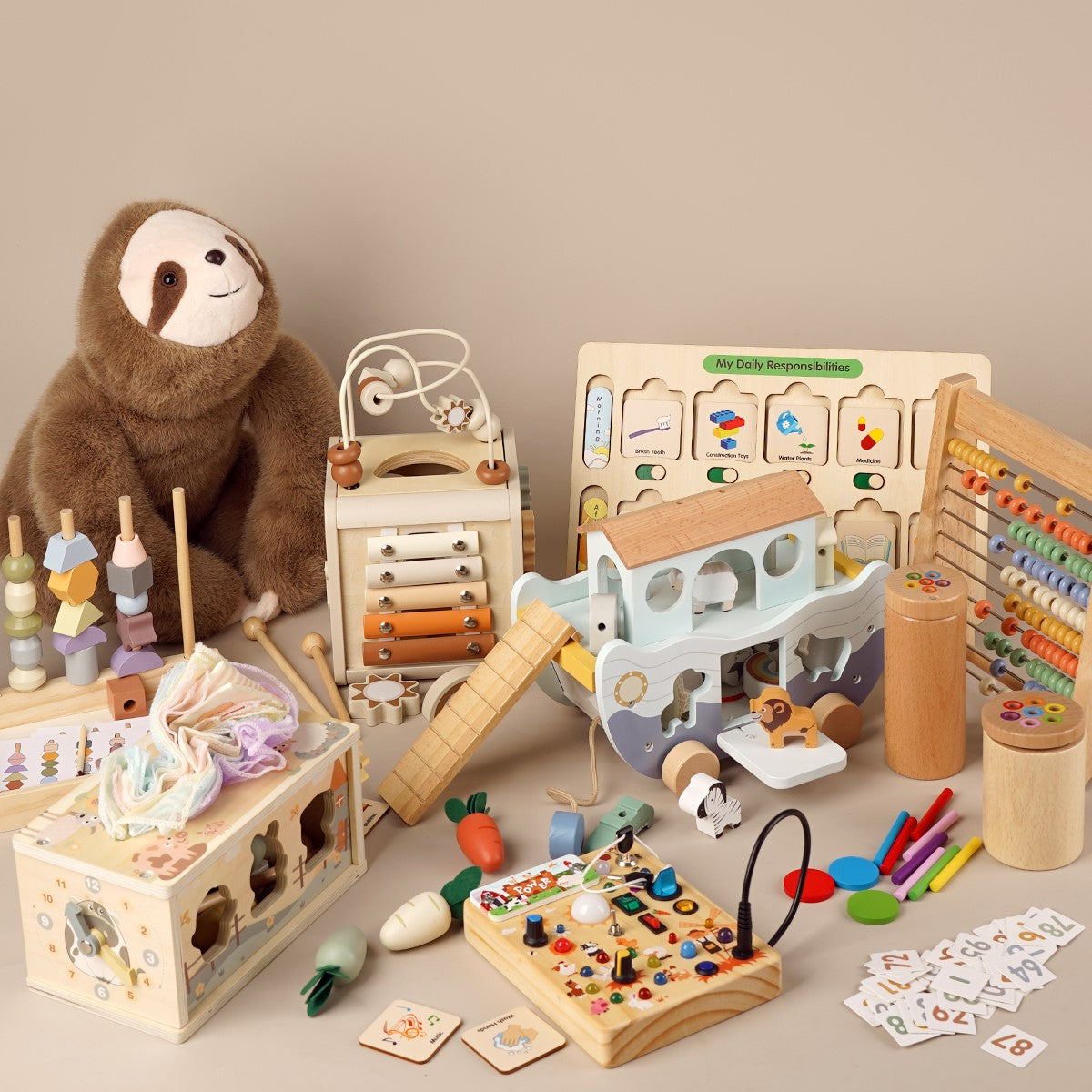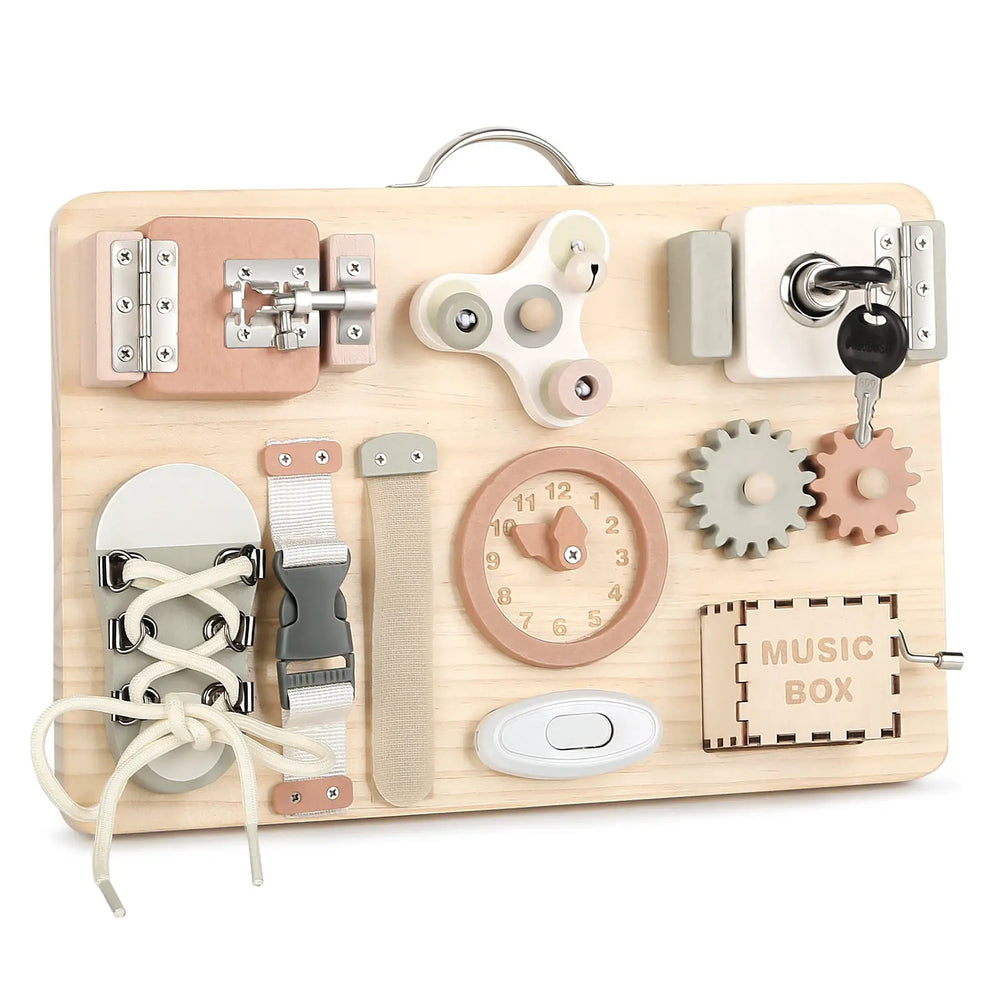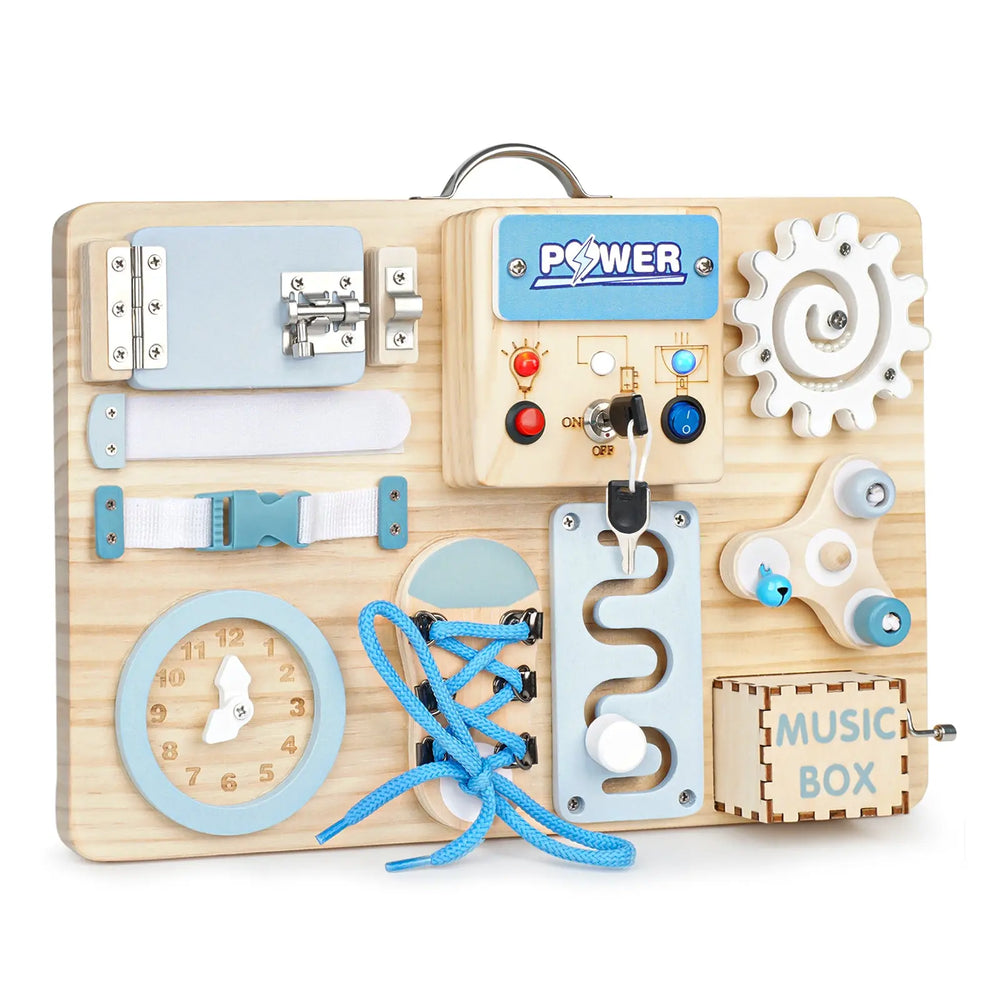Enhance Tactile Learning at Home with Montessori Busy Boards
What is Tactile Learning?
Tactile learning, often referred to as kinesthetic learning, is an educational style where individuals learn best by engaging in physical activities rather than by listening to lectures or watching demonstrations. It is one of the three primary learning styles, alongside visual and auditory learning. This method emphasizes touching, manipulating, and physically interacting with the learning material.
Key Features of Tactile Learning
- Physical Engagement: Tactile learners grasp concepts better when they actively participate in the process, such as conducting experiments, building models, or using manipulatives.
- Practical Approach: Learning-by-doing encourages better retention as it links abstract ideas to tangible outcomes.
- Improved Focus: Even complex subjects become more accessible when tactile learners can break concepts into tasks they can physically perform.
When to Start Tactile Learning?
Tactile learning can start as early as infancy and continues to be effective throughout life, as individuals of all ages benefit from hands-on engagement. For each stage of development, tactile learning plays a different yet significant role:
1. Infancy and Early Childhood (0–5 years)
Why Start Early? From birth, children explore the world through their senses. Infants and toddlers naturally adopt tactile learning as they touch, grasp, and manipulate objects to better understand their environment.
How to Encourage It?
- Sensory play: Letting babies experience different textures, like soft fabrics, sand, or water.
- Interactive toys: Providing age-appropriate toys they can stack, squeeze, or move.
2. Preschool Age (3–6 years)
Why Important? This stage is crucial for developing motor and cognitive skills. Tactile learning activities help lay the foundation for more abstract thinking in later stages.
Learning Activities:
- Play-dough or clay modeling to improve fine motor skills.
- Sand and water tables to explore concepts like measurement and volume.
- Sorting games to recognize colors, shapes, and patterns.
How Montessori Education Improves Tactile Development
Montessori education has gained significant recognition worldwide for its unique approach to learning, emphasizing hands-on, experiential learning. It is particularly effective at fostering tactile development—a crucial component of a child's overall growth. By incorporating tactile learning deeply into its teaching philosophy, Montessori education helps children develop fine motor skills, sensory perception, and cognitive abilities. Let’s explore how this method nurtures tactile development.
Why Touch Matters in Montessori Education

The Montessori method recognizes that tactile experiences are essential for a child’s physical, emotional, and cognitive development. Here’s how touch enhances learning in a Montessori classroom:
1. Interpreting the World Through Tactile Exploration
Children naturally explore their surroundings by touching objects. In Montessori education, specially designed materials—such as the Sandpaper Letters, Pink Tower, and Knobbed Cylinders—allow children to engage their sense of touch to understand concepts like:
- Texture (rough vs. smooth)
- Temperature (warm vs. cool)
- Weight (heavy vs. light)
- Shape & Size (discrimination through manipulation)
This hands-on approach helps children build a concrete understanding of abstract concepts.
2. Developing Fine & Gross Motor Skills
Montessori materials are intentionally designed to refine motor skills. Activities like:
- Transferring beads with tweezers (fine motor control)
- Walking the Line (balance & coordination)
- Using the Movable Alphabet (hand-eye coordination)
These exercises strengthen muscles and improve dexterity, preparing children for writing and other precision-based tasks.
3. Learning by Doing: The Montessori Philosophy
Dr. Maria Montessori believed that "the hands are the instruments of human intelligence." In a Montessori classroom, children don’t just listen—they touch, feel, and manipulate materials to internalize lessons. For example:
- Sandpaper Numbers teach numeral recognition through touch.
- The Binomial Cube introduces algebraic concepts through 3D assembly.
- Sensorial materials help classify and compare dimensions.
This experiential learning leads to deeper comprehension and retention.
4. Emotional & Social Connection Through Touch
Beyond academics, touch plays a crucial role in emotional well-being. In Montessori environments, positive touch—such as:
- Gentle guidance (a hand on the shoulder for redirection)
- Handshakes during greetings (social etiquette)
- Collaborative tactile games (building together, passing objects)
…helps children feel secure, builds trust, and strengthens social bonds.
Bringing Tactile Learning Home
Parents can reinforce Montessori-style touch-based learning with simple activities:
- Texture Scavenger Hunt – Find objects that are rough, smooth, bumpy, or soft.
- DIY Sensory Bins – Fill containers with rice, beans, or sand for exploration.
- Nature Touch Walks – Collect leaves, rocks, and sticks to compare textures.
Tactile Learning Made Easy: Joyreal Montessori Busy Boards for Home Use
The Joyreal montessori busy board is an excellent tool for helping children learn about touch in a fun and educational way. As part of Montessori education, busy boards emphasize hands-on exploration, sensory integration, and the development of crucial motor and cognitive skills.
1. Tactile Stimulation:
- Each board includes various textures and movable parts like zippers, buttons, and switches that engage children's sense of touch. This tactile experience introduces them to different sensations and builds sensory awareness.
2. Fine Motor Skill Development:
- Activities on the board, such as turning knobs or threading laces, improve finger strength, precision, and hand-eye coordination.
3. Practical Life Skills:
Kids can practice dressing skills like handling buckles and shoelaces, promoting independence in real-life scenarios.
4. Cognitive Growth:
- Features like light circuits and gears introduce young minds to early STEM concepts, problem-solving, and cause-effect relationships.
5. Sensory Integration:
- The repetitive motions of spinning, flipping, and pressing provide a soothing experience, ideal for children with sensory needs.
Why Montessori Busy Boards are Ideal for Learning at Home
A montessori busy board makes it easy for parents to create a tactile learning space without requiring a full classroom setup. Here’s how it promotes tactile skills at home:
1. Engages the Sense of Touch:
- Each element of the busy board, such as zippers, buttons, and latches, enhances sensory exploration by providing a variety of textures and movements.
2. Promotes Independent Learning:
- Montessori busy boards foster independence by encouraging children to solve problems and complete tasks on their own, such as fastening straps or threading shoelaces.
3. Encourages Quiet Play:
- Perfect for keeping toddlers engaged in meaningful, self-directed activities, busy boards offer productive "quiet time" for both kids and parents.
4. Supports Developmental Milestones:
- Fine motor skills: Activities like manipulating switches, knobs, and zippers develop dexterity.
- Gross motor skills: Interactive sections like buckles help strengthen larger muscle groups.
- Cognitive skills: Learning cause and effect, spatial reasoning, and problem-solving through the board’s various components.
Best Age Group for the Busy Board
- 12-18 Months: Encourages sensory exploration with simple latches and textured elements.
- 1.5-3 Years: Focuses on developing practical life skills and problem-solving with activities like buttons and gears.
- 3-5 Years: Allows for advanced learning with number mazes, shape sorting, and clock-telling tasks for cognitive readiness.
Benefits of Tactile Learning
Tactile learning brings several advantages:
- Enhanced Memory Retention: Doing tasks hands-on often leaves a lasting impression, making the memory retrieval stronger.
- Develops Problem-Solving Skills: By directly engaging with challenges, learners enhance creativity and critical thinking.
- Improves Coordination: Activities that require handling tools or objects enhance a learner’s motor skills and spatial awareness.
Conclusion
Touch is a powerful and essential tool for learning, and Montessori Education integrates tactile experiences into every part of its curriculum. By providing opportunities to explore materials, engage in sensory play, and perform practical life activities, Montessori environments help children learn about touch in meaningful, enriching ways. Whether at home or in a Montessori classroom, tactile learning creates a foundation for lifelong curiosity and development.
Maybe it will be helpful for you:
Recent Post

Buy Once, Play Longer with Joyreal Toys
“We’re tired of toys that only last a weekend.”“I want toys that gr...

Love Is Learning Together: Valentine’s Day Educational Toys by Joyreal
When we think of Valentine’s Day, our minds often drift to roses, c...

A New Year, A New Beginning: Joyreal Toys’ Wish for Every Child
A Heartfelt New Year Message from Joyreal Toys As we welcome 2026, ...

Can Montessori Wooden Toys Grow With Your Child From 1 to 4?
When Your One-Year-Old Plays for Two Minutes and Walks Away It’s a ...

Mini Piano or Drum Set — Which Is Best for Kids?
As parents, we all face the same struggle — our children spend hour...

Is Phonics-Based AAC Right for Your Nonverbal Child?
Why Nonverbal Children Need AAC Devices For many parents, finding a...

Picture-Based AAC or Phonics AAC? A Parent’s Guide
Phonics vs Picture-Based AAC: Which Communication Tool Is Right for...

How Does Music Enlightenment Work for Ages 0–3?
Why Age-Specific Music Enlightenment Matters (0–3 Years) The first...

What Age Is a Noah’s Ark Toy For?
Is a Noah’s Ark Toy Good for Toddlers (Ages 1, 2 & 3)? When par...

Why Noah’s Ark Is More Than Just a Story Toy?
When parents search for a wooden Noah’s Ark toy, they’re usually no...









